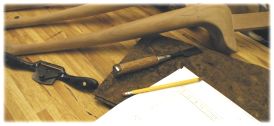|
Burl and Crotch Veneer
Some veneers are highly prone to warping. Burls and crotch veneers have unusual cell structures that expand and contract at different rates when there are changes in ambient humidity. These changes then affect the moisture content in those wood cells which causes buckling of the veneer. Burl and crotch veneer can be stored in anything that will prevent changes in moisture content. Plastic "cling" wrap or even a trash bag can be used for this purpose. Store the veneer flat and preferably with some evenly distributed weight on top.
Long Wood Veneer
Long wood veneers are typically rolled up for shipment. Once they arrive, it's best to slowly and carefully unroll the veneer and then store it flat. Exercise care when opening a roll of wood veneer. Don't let the veneer get out of hand and spring open as this could damage the wood.
Ideally, these veneers can be pressed between two pieces of plywood or MDF, shrink wrapped together tightly, and
then leaned against the wall or placed on a shelf. This method of storage minimizes changes in moisture content and prevents color fading caused by exposure to UV rays from sun and fluorescent light.
Rippled Veneer
Non-flat veneers such as burls and crotches are best flattened prior to use instead of prior to storage. The reason is that the flattening process can be short lived for many of the unstable veneers types. So why flatten a veneer twice? In my shop, I wait until a week prior to using the veneer before I start the process of flattening using veneer softener.
Shop Humidity
Considering running a dehumidifier if the veneer is stored in a basement or anywhere there is a high level of moisture in the air. If the area where you store the veneer is subject to heating in the colder months, then it's a good idea to invest in a humidifier to prevent over-drying the wood. I use a whole-house humidifier in the winter and a small dehumidifier in the spring and summer. This protects my veneers as well as my lumber and furniture projects.
End Tape
Some suppliers ship veneer with brown kraft tape applied to the ends to prevent splitting during transit. Removing this kind of tape can be a challenge and in my opinion, it is best to simply cut off the tape with a veneer saw. Instead of brown tape, I often use blue painter's tape on the veneers shipped to my customers from VeneerSupplies.com because this tape is easier to remove and the adhesive is mild enough to allow some expansion of the wood cells without causing buckling or splitting. To remove the tape without splitting the veneer, pull it off in the direction of the grain.
Some users recommend leaving the tape on the veneer until the veneer to be used on a project. I've found both positive and negative outcomes from doing so but as a general rule of thumb, I think it's best to leave the blue tape in place until the project is ready for the veneer work. Perhaps the most common exception to this rule is a wide flat-cut veneer which has a greater tendency to expand and contract with changes in moisture content. This is especially true for maple veneer.
If your veneer has a split, you can prevent it from advancing by placing small pieces of blue tape (or standard veneer tape) along the length of the split. This will allow the wood cells to shrink and expand each season without stressing the entire width of the veneer.
Shelf Life
Typically, there is no "shelf life" to a veneer when it is stored properly. I have used elm burl veneer that was sliced in the early 1970's and there was no problem.
|
Additional Veneer Storage Tips
Veneers stored in damp environments are subject to patches of mold. To prevent this from occurring, use a dehumidifier in the area where the veneers are kept. And should a patch of mold form, wipe on a light coat of oxalic acid (wood bleach) which is available in most hardware stores. It is often used to clean wood decks. Follow the directions on the container but be aware that it could cause darker veneers like walnut to lighten up a bit.
For
medium sized veneers, I prefer to sandwich them between two
oversized sheets of MDF or plywood. I then use screws, shrink wrap or
duct tape to hold the sandwich together.
Large
veneers can be stored unrolled too. I made a shelf above my garage
door from a 4 x 8 sheet of plywood. I keep a couple layers of trash bags over the veneers to minimize moisture changes. You also might also be able
to convince your spouse to let you store veneer under the couch or coffee table. Some of my best veneers are stored under my bed! |
|



